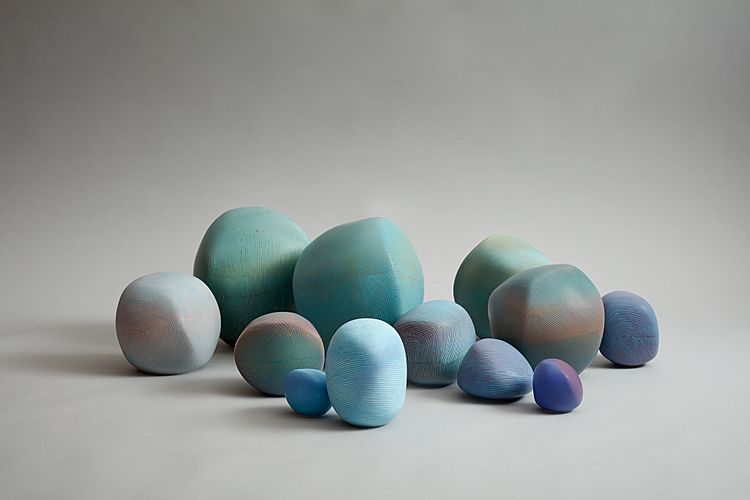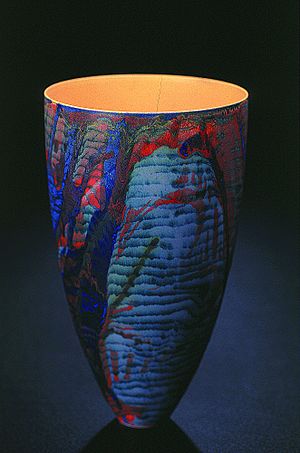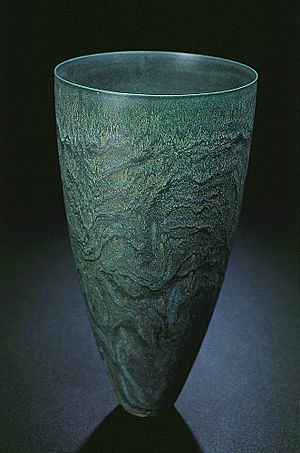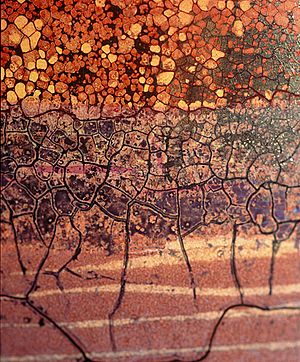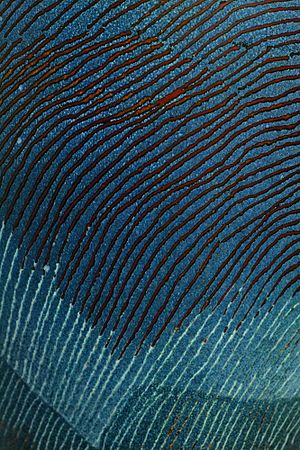Pippin Drysdale facts for kids
Quick facts for kids
Pippin Drysdale
|
|
|---|---|
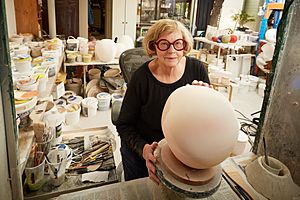 |
|
| Born |
Pippin Louise Carew-Reid
18 May 1943 |
| Nationality | Australian |
| Alma mater | Curtin University |
| Known for | Ceramic art |
| Style | Modernism, Abstract expressionism |
Pippin Drysdale (born 18 May 1943) is an Australian ceramic artist and art teacher. She is famous for showing the Australian landscape in her ceramic art. Her artworks use bright colors and lines to express her connection with the Australian landscape. In 2015, she was named one of Western Australia’s State Living Treasures.
About Pippin Drysdale
Early Life and Education
Pippin Drysdale was born in Melbourne, Australia, in 1943. She grew up in Perth from the age of three. Her father, John Hastings "Bunny" Carew-Reid, was a successful businessman. As a teenager, she took art lessons from William Boissevain.
Pippin was very good at art in school. However, she had trouble with other subjects because of an undiagnosed vision problem. This problem was found and corrected when she was 12. After school, she tried business and technical colleges but struggled.
She worked for a short time at her father's company. Then she became a secretary in Canberra. Later, she traveled and worked odd jobs in England and throughout Europe for a year.
Discovering Clay Art
In the early 1960s, Pippin returned to Australia and moved to Melbourne. She started selling Mexican paper flowers, calling them "Pip’s Flowers." In the 1970s, she moved back to Fremantle, Perth. There, she started a successful business selling herbs.
Pippin met a potter who made ceramic pots for her herbs. This is how she first discovered her love for clay. This led her to study ceramics. She earned an Advanced Diploma in Ceramics in 1982.
In 1982, she traveled to America to study with famous artists Daniel Rhodes and Toshiko Takaezu. Rhodes told her to continue her education at university. Takaezu encouraged her to create her own unique art style. Back in Australia, Pippin earned a Bachelor of Arts (Fine Art) from Curtin University in 1986.
After graduating, she continued to work and study. She visited places like Grazia Deruta Majolica Pottery in Italy and the Artists’ Union of Russia. She also studied at Tomsk State University and the Banff Centre for Arts and Creativity in Canada.
Pippin's Art Career
Pippin Drysdale is known as a painter who uses ceramics as her canvas. She is a master of color. Her main inspiration comes from the huge desert landscapes of Australia.
Inspiration from Landscapes
Pippin finds ideas for her art in places like the Pilbara, the Eastern Goldfields-Esperance area, the Kimberley, and the Tanami Desert. She also gets inspiration from landscapes in Pakistan, India, Russia, and Italy. She is moved by the colors and textures of these places. She puts her feelings about them into her artwork.
Pippin has taught ceramic art in many countries. These include Australia, Canada, the UK, Italy, and Russia. In 2007, she received a Master of Craft award. In 2015, the Government of Western Australia gave her the Living Treasure Award.
Developing Her Style
Pippin started by making simple bowls. Then she moved to making flat slab plates. She used these plates like canvases to draw with colored slips (liquid clay), glazes, and resists. She was influenced by artist Willem de Kooning. Her early work was known for its bright, complex colors and lively designs.
Later, she started making thrown vessels (pots shaped on a potter's wheel). She kept her free and spontaneous decorating style. She likes simple shapes that don't distract from the artwork on the surface. After studying in Europe, the USA, and Russia, she learned about majolica decoration and lustres. This led to her Totem and Carnivale series.
With help from grants, Pippin studied lustres in detail. This resulted in her Over The Top series, which features rich gold and platinum lustres.
Collaborations and New Techniques
The landscapes of Western Australia inspired her Landscape Lustre (1994), Pinnacles (1995), and Eastern Goldfields series. Around this time, Pippin began working with master potter Warrick Palmateer. This allowed her to focus on decorating the surfaces while he created the vessel shapes.
Her use of glazes and lustres reached a high point in the Pakistan series. For these pieces, she applied many layers of glaze. After each layer, she would cover the piece in paraffin wax, scrape it back, and fill it.
Later Works and Signature Style
Pippin later moved away from waxes and lustres. She started using a safer material called Liquitex. This allowed her to make her line work even finer.
A key moment for Pippin was a 1998 airplane flight over northern Australia. Flying low over the Great Sandy Desert and the Tanami Desert, she was amazed by the endless parallel sand dunes. Their lines and the way light and shadow played on them deeply impressed her. The lines in her art also reflect the exposed rock layers in Australian deserts. Her ceramics truly show the colors and patterns of the land.
She was also influenced by Indigenous Australian painting. She owns works by Indigenous artists Queenie McKenzie and Kitty Kantilla. McKenzie's influence can be seen in the stacked landscape segments that stretch to the horizon. Kantilla's influence is clear in the parallel, slanting, or vertical lines within these segments.
Bringing all these ideas together, Pippin developed her signature style. This style uses intense color and fine line work. Her first Tanami series, called Red Desert (2003), was a great success.
Her technique involves choosing a suitable vessel. Then she adds layers of glaze. Next, she carefully cuts lines with a knife through a masking resist. This creates the detailed patterns. Because the masking material dries quickly, she can only work on a small section at a time. The cut lines are then brushed out and filled with thick color. Any extra color is removed.
Another feature of Pippin's later work is her groups of asymmetrical pieces. These are sets of closed forms that look like geological features of Australia. An example is the Devils Marbles series, inspired by the Karlu Karlu / Devils Marbles Conservation Reserve in the Northern Territory.
Pippin finds constant new energy in the creative process. She has felt this since she first touched clay. She once said, "I can't believe that I'm still sitting here today, committed to clay. I finally found something that I thought was going to be a life time thing. I think the thing about being a ceramic artist, a potter, is that you are constantly learning and are challenged by it so you never get bored. You're just constantly extending yourself in lots of ways."
Pippin's Studio
For the last 30 years, Pippin's studio has been her home in Fremantle. It's a renovated worker's cottage that her father bought for her. Her pottery is shaped by Warrick Palmateer, who also studied at Curtin University. Pippin has a team of helpers in her studio. They mix glazes, test colors, fire the pieces, sand the bisque-ware, and help with online work and shipping. The porcelain clay she uses is prepared carefully. It is pressed many times, wrapped for four weeks, and then pressed again before it's ready to use.
Where to See Her Art
Pippin Drysdale's artworks are in many private collections. Sabbia Gallery represents her art in Australia. The 12th Duke of Devonshire, Peregrine Cavendish, has a large collection of her works (over 100 pieces).
Her art can also be found in many public collections around the world. These include:
- National Gallery of Australia
- Art Gallery of Western Australia
- Powerhouse Museum
- Auckland Art Gallery
- Queensland Art Gallery
- Tasmanian Museum and Art Gallery
- Museum and Art Gallery of the Northern Territory
- National Museum of Scotland
- Museum of Fine Arts, Gifu
- Tomsk State Gallery and Museum
- Novosibirsk State Art Museum
- Victoria and Albert Museum ceramic collection, London
Awards and Honors
Pippin Drysdale has received several important awards:
- Western Australia’s State Living Treasures in 2015
- Lifetime Achievement Award — Artsource Australia
- Major Fellowship Grant from Australia Council for the Arts in 2007
Gallery
Early work
See also
- Australian art


